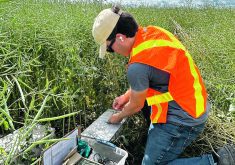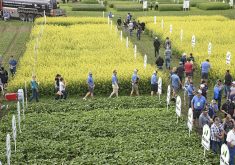Alberta’s spectacular economic and population growth has delivered benefits but has also come at a cost. It has pressured the environment and created conflicts between land uses.
A provincial system of regional planning was created in 2008 to co-ordinate growth and reduce conflicts, but the system and the laws that created it face sharp criticism from those who believe it runs roughshod over property rights.
In this report, The Western Producer’s Barbara Duckworth sets out Alberta’s land-use framework and the views of its supporters and critics.
Read Also

Geopolitics can change trade routes
WHISTLER, B.C. — Today’s geopolitical tensions could have dire long-term consequences, says the director of international policy at the University…
James Hargrave prefers chasing cows to getting involved in politics.
However, he felt he had to step forward when he heard about the provisions in a new land-use plan proposed for Alberta.
The Alberta Beef Producers delegate agreed to research the Alberta Land Stewardship Act, or Bill 36, as part of a special ABP committee.
The province has promised to amend Bill 36 and remove controversial clauses over property rights, compensation and the right to appeal, but Hargrave remains distrustful.
“I don’t think they know where they stand on this. They contradict themselves so many times it is hard for me to trust…. Or are they are just doing this to smooth things over?” said Hargrave, who ranches near Walsh in southwestern Alberta.
He also recently learned that provincial maps showing potentially environmentally sensitive land include some of his property.
Sensitive land might include the habitat of species at risk, special topography or riparian areas.
Hargrave believes Bill 36 should be repealed.
“If they want to do this right, they are going to have to take it back to square one, peel it right down,” he said.
“I agree 100 percent that Alberta needs land-use planning. We have many different industries that work on our landscape, but planning needs to encompass property rights.”
The legislation includes provision to pay ranchers for conservation, but Hargrave said they don’t know if that means they would have to abandon the land and lose grazing or be restricted in developments such as water projects or fencing.
“It severely restricts what you can do with it.”
When the land-use framework was proposed, many thought it was simply an overarching planning document for a fast growing province.
But is was more than that , said Keith Wilson, an Alberta lawyer who specializes in agricultural and environmental cases.
“It is almost like the land-use framework and the Land Stewardship Act are like one is from Mars and one is from Venus,” he said. He thinks the most troubling part of the law is Section 11, which grants the government the right to extinguish rights:
“For the purpose of achieving or maintaining an objective or a policy of a regional plan, a regional plan may, by express reference to a statutory consent or type or class of statutory consent, affect, amend or extinguish the statutory consent or the terms or conditions of the statutory consent,” the section reads.
Wilson is also troubled by words in Section 19:
“No person has a right to compensation by reason of this Act, a regulation under this Act, a regional plan or anything done in or under a regional plan.”
Wilson said those sections surprised many producers and producer organizations that participated in consultations relating to the landuse framework program.
“There was never any discussion about putting provisions in the enabling legislation that would give the cabinet, effectively 13 politicians sitting around the table in Edmonton, the legal authority to extinguish existing rights.”
He said Albertans were promised that the framework would solve conflicts between agriculture, oil and gas, forestry, aboriginal groups and cities, yet Section 15 says no one can bring a court claim against the government to receive damages when land is set aside for the public good.
The province has promised to amend those passages.
“Not every policy decision should be litigated in the courts, but what is critical here is cabinet will be making decisions affecting individual people’s land,” Wilson said.
“It is amazing to me that any government would think it is OK to write legislation with these types of blanket powers and at the same time removing the traditional checks and balances that exist in a constitutional democracy.”
Despite the provisions to pay landowners for ecological goods and services, Wilson doubts taxpayers or the marketplace will pay for environmental protection.
“The way that we have traditionally in our economy and our society recognized good stewardship is through respecting people’s property rights and their land. If you own it and you look after it, it will be worth more later,” he said.
“To replace that with a legislative framework that instead gives supreme land-use making decisions to the cabinet and then trying to supplement whatever disruption that causes by doing this abstract concept of ecological goods and services, I just think it is folly.”















